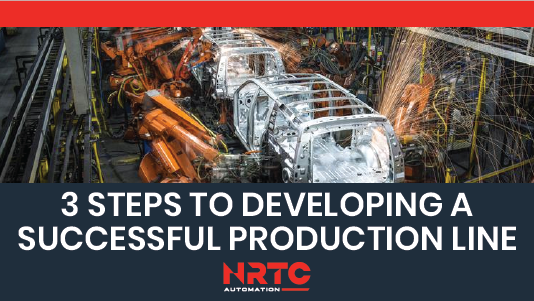3 Steps to Developing a Successful Production Line
Manufacturers can create more efficient and effective production lines with a little planning.
Since the late 1800s, manufacturing has seen massive improvements in production. With little tweaks and modern technologies, manufacturers have been able to grow without bounds.
Today, staying relevant in the industry means manufacturers must plan for the success of their production lines. Competition is fierce in a global market, and staying on top of trends is necessary to rise above the rest.
Thankfully, you don’t have to go about it alone. With NRTC Automation’s resources, you can build a production line that serves you and your customers with quality and speed.
Learn our three steps to developing a successful production line below.
A successful production line is key to a successful business
Your production line is the heart of your business. Why is that?
It contains everything your business promotes to your customers: quality assurance, delivery speed, and plentiful supply.
To keep those promises, you must ensure that your production line is highly refined and well-attended.
That way, you will consistently provide your customers with:
Uniform, high quality, and durable products
Minimal lead time from customer order to date of shipment
A continuous supply to meet their demands
However, just as CEOs have to plan and work to create a successful business, manufacturers must be strategic when developing their production lines.
3 steps to developing a successful production line
To meet the needs of your customers and continue to grow as a company, consider these three tips to enhance your production line.
1. AUTOMATE, AUTOMATE, AUTOMATE
Automation is the holy grail of manufacturing. Since the Industrial Revolution, manufacturers have been steadily automating processes to deliver their products faster.
An example of this is when Henry Ford installed the first assembly line in 1913, effectively reducing production time for one car from 12 hours to one hour and 33 minutes!
Since then, the manufacturing sector has seen vast improvements in production. Industrial robots were introduced in the mid-twentieth century and have advanced significantly since. Payloads are higher, applications are more flexible, arms and wrists are more refined, repeatability is more precise, and more.
Automation is nothing new, and it is even more crucial now in 2021 as competition gets more intense and the global market introduces millions of potential customers.
Add a KUKA industrial robot, FANUC robot, or ABB robot to your production line to keep up. If you are new to automation and need help getting started, NRTC Automation can design, build, and engineer a custom work cell for your company.
Visit our Automation Services page to learn more about how we can help you improve throughput and capacity by over 200 percent.
2. STAY ON TOP OF MAINTENANCE
If you have already automated your production line, then staying on top of maintenance is absolutely necessary for the longevity of your equipment.
Preventative maintenance will protect your equipment from breakdowns and part failures. Each piece of equipment will have a different maintenance schedule depending on the make and model, so be sure to keep equipment manuals in a central location to reference them when needed.
What does machine maintenance usually consist of?
Routine checks
Replacing old or worn parts
Cleaning out old grease and replacing it with fresh grease
Replacing filters
Paint jobs
Replacing batteries
Whether it is every three months or once a year, keeping up with your equipment maintenance schedules allows your equipment to work as efficiently as possible. Plus, regular maintenance will save you time and money on buying new equipment.
Want to further extend the life of your industrial robots? Get Industrial Robot Refurbishing Services at NRTC Automation!
Plus, if you are in need of replacement parts, visit our sister company, iGAM. Their online marketplace is constantly growing with refurbished equipment and parts to complete your production line.
3. GET LEAN
Last but not least, use lean manufacturing methodology to get your production line in the best shape possible.
Lean methodology aims to reduce waste as much as possible to improve production efficiency. Think about it: the less waste that is produced during manufacturing, the less energy that is taken away from important production processes.
There are plenty of methods to choose from—just choose the right method for your company’s manufacturing needs. Some examples include:
5S
Cellular Manufacturing
3P
Kaizen
Kanban
Six Sigma
You can read the definitions of each of these methods on NRTC Automation’s glossary.
Start using lean manufacturing methodology to further improve your production line and get ahead of the competition.
Improve your bottom line today
In manufacturing, efficiency is fundamental to success in today’s market.
You’ve worked hard to get to where you are. Try out the tips we’ve listed above to get to where you want to be.
WORK WITH NRTC AUTOMATION
NRTC Automation is dedicated to providing high-value industrial automation and manufacturing equipment solutions to all its customers.
From decommissioning and tear out to industrial robotic training services to custom flexible work cells, NRTC is the key to integrate your workplace. With personalized training and custom-built designs, NRTC Automation is the destination for all your industrial automation and manufacturing equipment services.
Schedule a free consultation with NRTC today to get the best automation plan for your company's specific needs.

